Aberdeen Corporation Tramways
History
Aberdeen Corporation became a tramway owner and operator on the 26th August 1898, when it purchased the Aberdeen District Tramways Company, a private company that had built up a standard-gauge horse tramway system in the city of approximately 11.87 miles. Like most municipal authorities, the decision to operate its own tramways, rather than allowing private enterprise to have free reign, was based on a mixture of civic pride, and a strongly held view — prevalent at the time — that tramways ought be run for the benefit of the populace, with profits accruing to the city and not to company shareholders.
The first line to be converted to electric traction was the Woodside route on the 23rd December 1899, which ran roughly northwest from Union Street (the main thoroughfare of the City). This was followed by: a new line eastwards to Sea Beach (opened in sections commencing on the 4th July 1901); conversion of the horse tramway route southeastwards to Mannofield (opened on the 8th April 1902); conversion of the horse tramway route eastwards to Bayview (opened on the 27th May 1902); conversion of the horse tramway routes north and southwards to the Bridge of Don and Bridge of Dee (fully opened on the 29th May and the 2nd June 1902, respectively); conversion of the horse tramway around Rosemount Circle (opened on the 2nd June 1902); a new circular route to Ferryhill at the southwestern end of Union Street (fully opened on the 12th November 1903); and lastly, a new line southeastwards to Torry (opened initially on the 10th October 1903, but not joined to the rest of the system until the 15th July 1905). The last horse tram ran on the 2nd June 1902. The system reached its maximum extent — 16.12 miles — in the 1920s, when the extension to Hazlehead was built.
The corporation (or luminaries within it) also encouraged a private company — the Aberdeen Suburban Tramways Company — to build and operate two lines that were effectively extensions to its own system, but which were outside the municipal boundary. One line ran southwestwards from the corporation's Mannofield terminus to Bieldside (opened on the 23rd June 1904), and the other westwards from the Woodside terminus to Bankhead (opened on the 8th July 1904). Through-running agreements were in place from the start, allowing ASTCo cars to run into central Aberdeen, thus avoiding the need for passengers to change cars at the municipal boundary. Through-running required a strong degree of cooperation, something that worked well initially, but in later years (the mid 1920s), as the ASTCo cars and services became ever more decrepit and unreliable, the relationship ultimately fractured, with the corporation eventually terminating the agreement.
Like most tramway systems, Aberdeen's emerged from the Great War in poor shape — with aged tramcars and much of the track in need of renewal — having had to 'make do and mend' for the best part of four years. The costs of putting the tramway back on a firm footing were so large, that any thoughts of extensions, save for the government subsidised line out to Hazlehead (opened on the 16th July 1924), rapidly evaporated; instead, the ACT turned its thoughts towards motorbus operation, introducing its first bus service (to Footdee) on the 10th January 1921.
Aberdeen was one of the few municipal victors in the so-called 'bus wars' of the mid-1920s, aggressively competing with bus operators, and ultimately passing bye-laws that prevented them from picking up or setting down at tram stops. Despite these robust actions, tramway takings suffered significant decline, whilst those from the ACT buses rose considerably. Although tramway abandonment was not on the agenda in the 1920s, what had become clear, was that buses would play an increasing and ultimately dominant role in the corporation's thinking. This was reflected in the name of the department, which was changed to Aberdeen Corporation Transport in November 1930.
The first tramway closures came in early 1931, though these were relatively short and unremunerative routes (Ferryhill and Torry); the closures were, however, balanced by significant investment in modernisation of the tramcar fleet.
Following the challenges of the Second World War, it was clear that the tide had turned in respect of tramway operation, and by January 1951, the corporation had formally decided to abandon the system. The first route to go was that out to Sea Beach on the 3rd March 1951, with the last tram of all running on the 'Bridges' route on the 3rd May 1958.
Uniforms
Following the takeover of the horse tramway on 26th August 1898, drivers and conductors continued to wear the long greatcoats favoured by their former employers — the Aberdeen District Tramways Company — as these were deemed (by the Tramways Committee) to be in good condition and therefore fit for continued use. New soft-topped caps were, however, issued, some with material peaks and some with glossy peaks; photographs suggest that the former were worn by drivers, and the latter by conductors. Initially, no badges or insignia of any kind were carried on either the coats or the caps; however, as electrification proceeded towards completion, the remaining horsecar staff were issued with double-breasted greatcoats and kepi-style caps. The latter bore embroidered grade badges, 'Conductor' or 'Driver', probably in brass.
To mark the inauguration of the new Woodside electric service in late 1899, staff working on the route were issued with new single-breasted jackets with four buttons and lapels; it is unclear whether any insignia were carried on these early uniforms. Headwear took the form of kepi-style caps, which bore script-lettering cap badges — either 'Motorman' or 'Conductor' — again probably in brass; the caps appear to have had a wide band of darker material on which the badge was carried. Motormen were also issued with dark grey overcoats piped in red; these garments had silver buttons (presumably nickel) bearing the city coat of arms.
The style of uniform appears to have been subjected to a series of alterations during the first five or so years of the system's life, eventually settling down into a recognisable pattern/policy. Conductors and motormen were issued with full uniforms on 13th June 1900. These comprised single-breasted tunics — probably grey — with five brass buttons bearing the full system title (see link), and lapels; conductors tunics bore two breast pockets (with button closures), whilst motormen's tended to have a single open breast pocket. Initially, the collars appear to have borne embroidered 'A C T' initials, though these were soon replaced by a one-piece brass system-initials badge, 'ACT'. A distinction also appears to have been made between conductors and motormen in respect of their caps: conductors invariably wore kepis, whilst motormen wore soft-topped peaked caps, which were superseded — around 1903 — by smarter tensioned-crown peaked caps. Standard script-lettering grade badges continued to be worn on the caps, though the occasional photo does show the metal 'ACT' collar badge being worn instead, probably the result of overlapping uniform issues and the re-use of existing tunics.
At some point in the mid-Edwardian era, a new brass cap badge was introduced; this was worn above, and in addition to, the standard script-lettering grade badge; it comprised the arms of Aberdeen, within a open circular border, and with a ribbon below, the border and the ribbon bearing the full system title, 'ABERDEEN CORPORATION TRAMWAYS', inlaid with red enamel. At around the same time, conductors' kepis were superseded by drooping-peak caps.
The cut of the uniforms was changed again in the 1920s to give a more modern feel, but with conductors having single-breasted tunics, and motormen double-breasted; caps were now exclusively of the tensioned-crown variety. Apart from minor alterations in cut, the style of the uniforms (and the caps) essentially remained unchanged for the next 30 years (up until to the demise of the tramway in 1958).
Following the creation of Aberdeen Corporation Transport Department in 1931, badges and buttons were changed to reflect the new title (initially in brass, but later in chrome), and were to all intents and purposes identical to those previously used, but with the word 'TRAMWAYS' replaced by ''TRANSPORT'. The new insignia were almost certainly introduced on a piecemeal basis, as and when new uniform issues were required. One other change, which seems to have been made late in the tramway's life, was a switch to underlined, script-lettering grade badges, rather than the traditional non-underlined variety, with some motormen wearing 'Driver' badges rather than the usual 'Motorman'.
Tramcar crews were also provided with greatcoats. In the early years, a variety of single- and double-breasted styles were used, all seemingly devoid of insignia. However, following the application of one-piece system-initials badges to tramcar crew jacket collars in the early-Edwardian era, these were also applied to the high, fold-over collars of the greatcoats.
Three inspectors appear on the early Woodside and Mannofield depot photographs below, and it is clear that their uniforms were intended to be considerably smarter than those of the tramcar crews. Whilst the jackets were similar in style to those worn by conductors and motormen, the sleeves and trousers were prominently piped in gold, and the upper lapels were edged in gold braid; the ostentatious gold embellishments must have contrasted impressively with the darker blue material of the main garment. Waistcoats, wing-collared shirts and ties were also worn. The caps, which were of the drooping-peak type, were piped at the top and the bottom (probably in gold), between which a large municipal-device badge was worn (see below). It is probable that both the badge and buttons were nickel rather than brass.
This style of uniform appears not to have been used for very long, as a photograph taken around 1904/5 (possibly earlier) shows two inspectors wearing single-breasted jackets with hidden buttons (or more likely an hook and eye arrangement), two breast pockets (with button closures) and stand-up collars; the jacket was edged in a finer material than the main body. The collars bore badges on each side, which stated the grade — 'Inspector' — possibly preceded by system initials ('ACT'), though these cannot be made out with certainty on the surviving photographs. The caps, which were still of the drooping-peak type, bore the same prominent cap badge — depicting the arms of Aberdeen — but mounted on a more subdued hatband, ostensibly the same colour as the cap; the hatband was piped in material of a lighter colour, in all probability silver. At some point, silver piping was also applied to the jacket collars, and the drooping-peak caps were superseded by tensioned-crown peak caps; the cap badge, however, remained unaltered.
By the late 1920s, inspectors' uniforms had evolved to a modern design, still single-breasted, but with four buttons, two waist and two breast pockets (with buttons closures) and lapels; the collars, which were no longer piped, bore 'Inspector' in embroidered script lettering.
In common with the vast majority of British tramway systems, Aberdeen employed female staff in considerable numbers during both world wars to replace male staff lost to the armed services. According to the Aberdeen Evening Express, the first eight Great War conductresses (referred to as 'conductors' by the paper) took up their duties on Saturday the 22nd May 1915. The ladies first began driving the trams in January 1917. Female tramcar staff were issued with navy blue uniforms with red facings. These comprised single-breasted jackets with lapels, two button-closed breast pockets and long matching skirts; the jacket collars carried the standard system-initials badges. Headgear comprised dark-coloured waterproof straw bonnets (probably for use in summer) and large-crown caps with cloth-covered peaks (presumably for winter wear); both types carried the standard 'Tramways' cap badge, as well as a grade badge, either ' Motorman' or 'Conductor'. Long, tailored, double-breasted topcoats were also worn; these bore five pairs of buttons, a waist belt (with two buttons) and high, fold-over collars carrying the standard 'ACT' collar badges.
During the Second World War, conductresses were issued uniforms that were very similar in style to those issued to male staff, though appropriately tailored. The main difference was the use of a baggy cap with a glossy peak; these carried script-lettering grade badges, but without the red enamel cap badge worn by their male colleagues.
With grateful thanks to Mike Mitchell for sharing his photos and knowledge, and for his patience in unravelling this complex chronology, as well as to Alan Brotchie who also provided several nuggets of information.
Further reading
For a history of public road transport in Aberdeen, see 'Fae Dee to Don and Back Again' by M Mitchell; First Aberdeen (1998).
Images
Horse tram drivers and conductors
A very smartly turned-out horse car stands at the Bridge of Don terminus on the day of the corporation takeover — 26th August 1898. Though no uniforms are being worn, both men are nevertheless very smartly turned out. 
An enlargement of the above photograph showing the conductor. He is wearing a flat cap and the usual cash bag with prominent buckle. There appears to be something resembling an oval licence below the buckle, though it is far from clear what this actually is.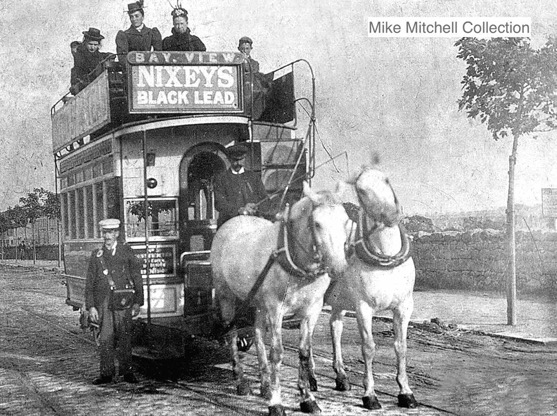
A horsecar crew pose for the camera at the Bayview Terminus — photo undated, but probably taken during corporation ownership.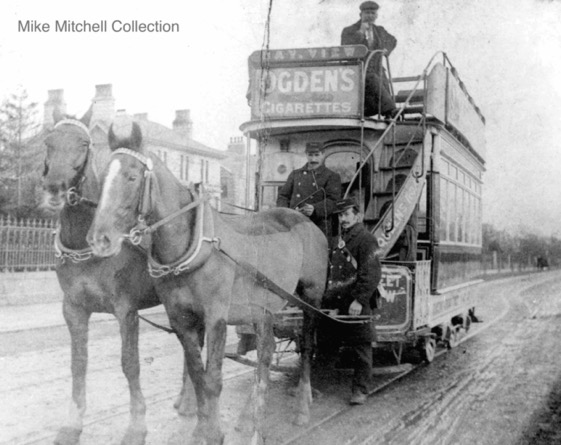
Another view of a corporation horsecar at the Bayview Terminus — photo undated, but very probably taken in 1902.
An enlargement of the above photograph showing the impressively named conductor, Litentius Falconer, and his driver, William Milne. Both men are wearing informal attire, but with corporation-issued greatcoats and kepi-style caps; the latter appear to carry the mens' grades in embroidered script lettering. The reflective triangle half-way down the conductor's cash-bag strap is almost certainly a brass cash-bag strap end.
Motormen and conductors
Motorman C Wight at the controls of Tramcar No 2 at Anderson Road on the Woodside route in November 1899, a month before the official opening. The silver (nickel) buttons were possibly marked, but other than that, the corporation-issued greatcoat and soft-topped cap are completely devoid of insignia.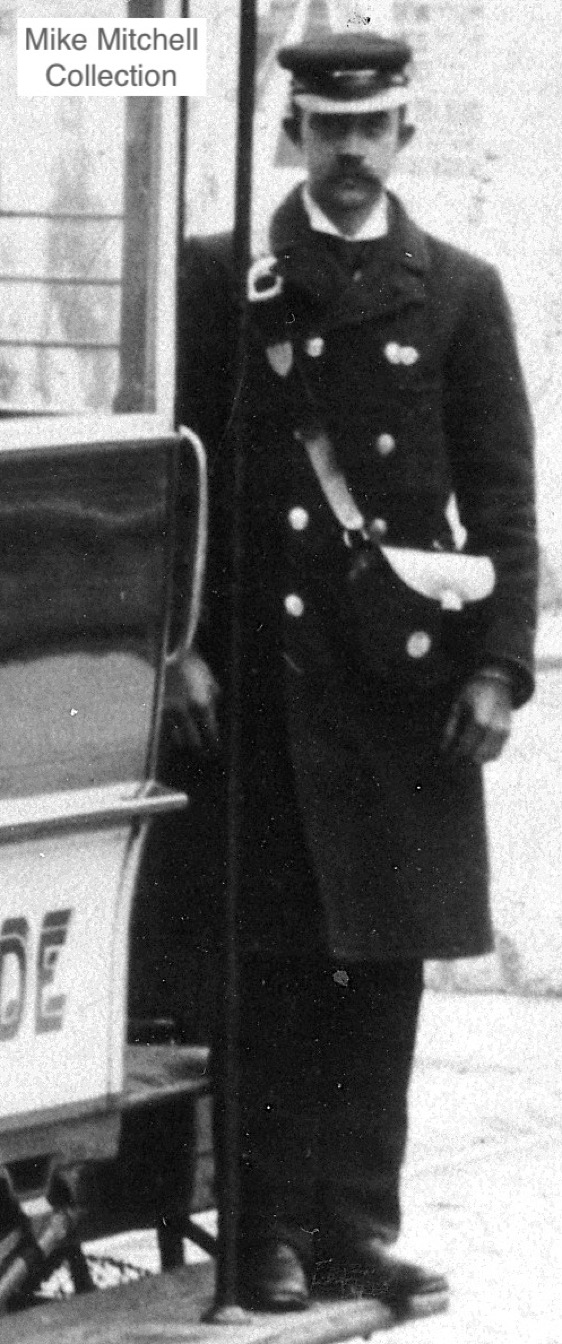
From the same photograph as the previous image, the conductor, standing on the rear steps. The reflection on his cap is almost certainly from the chin strap, which was always worn above the peak.
A staff photograph taken outside Woodside Depot, probably to mark the inauguration of the first electric service on 23rd December 1899. Apart from depot staff, all present are wearing single-breasted jackets and kepi-style caps, those of the conductors and motormen adorned with script-lettering grade badges, and the inspectors with a municipal-device badge (probably that shown below). The gentleman in the centre, wearing a Homburg, is Tramways Convener Baillie Alexander Wilkie, later Managing Director of the Aberdeen Suburban Tramways Company.
A conductor and a motorman pose with Tramcar No 18 on the Mannofield route — photo undated, but probably taken in 1902, the year the route was converted to electric traction. Both men are wearing single-breasted jackets, and appear to have 'A C T' initials embroidered on their collars. Whilst the conductor is wearing a kepi-style cap, the motorman clearly has a soft-topped peaked cap. Note that the conductor appears to be wearing an ' ACT' badge on his cap; a one-piece version of this badge was subsequently carried on the collars of tramcar-crew tunics.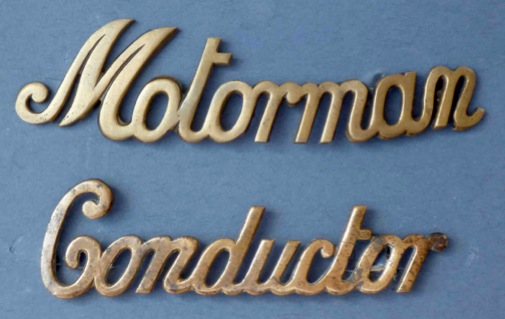
Standard off-the-shelf script-lettering grade badges of the type used by Aberdeen Corporation Tramways on tramcar-crew caps — brass. Author's Collection.
A staff photograph taken at Mannofield depot — photo undated, but probably taken in 1902/3. All the tramcar staff have script-lettering grade badges on their caps; the conductors have kepis, whilst the motormen have soft-topped peaked caps.
A conductor and a motorman pose with Tramcar No 12 on the Rosemount route — photo undated, but probably taken around 1903. Although the general style of the tunics is unchanged from the previous photo, one-piece metal collar badges had clearly been introduced by this time, along with tensioned-crown peaked caps for motormen.
ACT collar/cap badge — brass. These were worn from around 1903 through to the 1930s. Author's Collection.
A conductor and a motorman aboard Tramcar No 53, which is standing at the Bridge of Don terminus looking north — photo undated, but probably taken around 1906. My thanks to Mike Mitchell for identifying the approximate date and location.
An enlargement of the above photograph showing the conductor and the motorman. Both men's caps bear a circular ACT cap badge above their script-lettering grade badges; the conductor's cap is of the drooping-peak type, these having replaced the older kepi style by this time.
Aberdeen Corporation Tramways cap badge — brass inlaid with red enamel. These cap badges, in brass, were worn from from the mid-Edwardian era through to the 1930s, when the name of the department was changed to Aberdeen Corporation Transport. Author's Collection.
A conductor and a motorman pose aboard Tramcar No 15 at the Mannofield terminus on the Great Western Road route, presumably about to set off with a service to Castle Street — photo undated, but probably taken around 1908 to 1910. With thanks to Ian Souter for information on the location and probable date. Author's Collection.
An enlargement of the above photograph showing the crew, who are both wearing a brass and red enamel ACT cap badge above their script-lettering grade badges.
The crew of Tramcar No 47 pose with their charge on the Bridge of Dee route — photo undated, but probably taken between 1912 (when the folding windscreen was fitted) and the start of the Great War. With thanks to Mike Mitchell for the dating. Author's Collection.
An enlargement of the above photograph showing the conductor and the motorman.
A conductor and a motorman pose with Tramcar No 80 at Hazlehead around 1925. By this time, the uniforms had been given a more modern cut, especially the motorman's double-breasted jacket. Conductors had by this time also been switched to tensioned-crown peaked caps. 
Two motormen pose for photographer M J O'Connor inside Tramcar No 99 at Woodside in 1954. The basic style of the uniforms and the insignia, are almost unchanged from 30 years previously. With thanks to the National Tramway Museum. 
An enlargement of the above photograph showing one of the motormen. He is wearing an under-lined grade badge, presumably chrome, which appear to have superseded the earlier non-underlined type, possibly from the early-to-mid 1930s onwards.
General issue chrome cap badge (inlaid with red enamel) worn by motormen and conductors. This style of badge was probably issued to new employees from the early-to-mid 1930s onwards. Author's Collection
ACT lapel badge — chrome. Badges in this material were probably issued to new employees from the late 1930s onwards. Author's Collection.
A motorman and a conductor once more posing for the camera of M J O'Connor, this time inside Tramcar No 135 at Kings Gate in 1954. With thanks to the National Tramway Museum. 
Motorman W Hay and Conductor T Watson with Lord Provost Stephen, and Aberdeen's last tram (No 36), on 3rd May 1958. Motorman Hay is wearing an underlined, script-lettering 'Driver' cap badge, rather than the usual 'Motorman' variety. Photo courtesy of the Stephen Howarth Collection.
Underlined script-lettering grade badges — chrome — of the type used by the ACT late in the tramway's life. Author's Collection.
Senior staff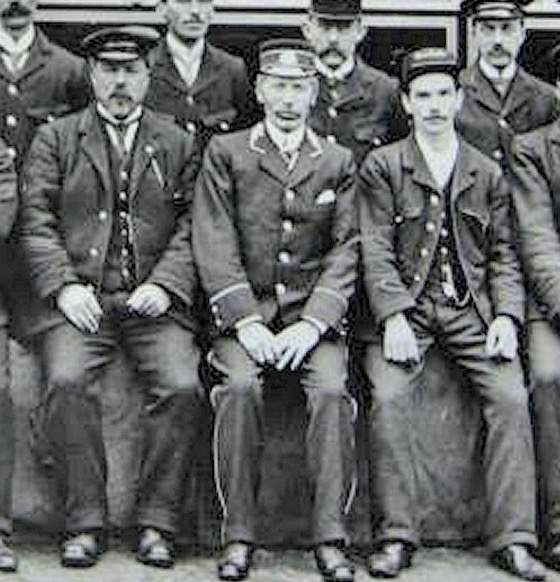
An enlargement of the circa-1903 Mannofield depot staff photograph above, showing a motorman, an inspector and a conductor. The smart nature of the inspector's uniform — which was probably piped in silver — is easy to see.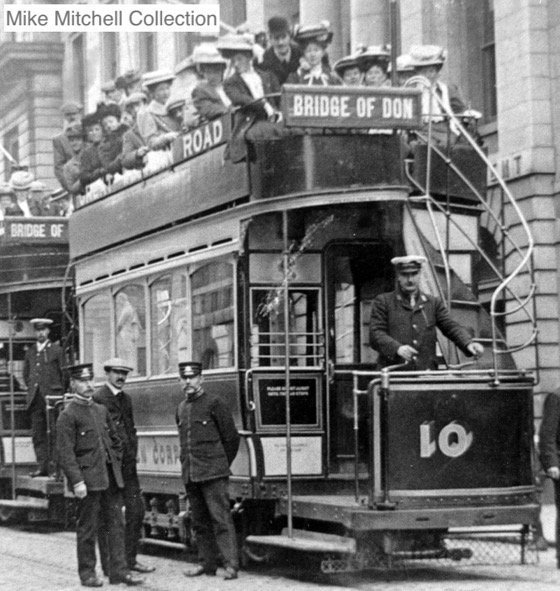
Two inspectors supervise what is evidently a special working to Bridge of Don, no doubt for a society of some description — photo undated, but probably taken in the mid-Edwardian era. Both the inspectors are wearing typical 'tramway inspector' garb (single-breasted jackets closed with an hook and eye arrangement) rather than the more elaborate earlier jackets.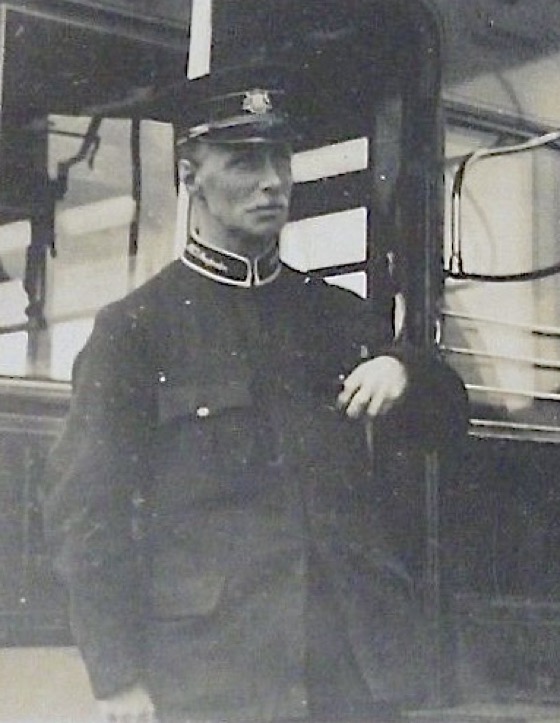
An inspector stands on the platform of Tramcar No 80 — photo purportedly taken on the promenade in 1923. The collars are piped, and appear to bear an embroidered badge comprising the grade and system initials; his tensioned-crown peaked cap bears a municipal-device cap badge, almost certainly rendered in nickel. 
An ACT inspector’s cap badge — nickel. Author's Collection.
Inspector Pat Oliphant talks to H B Priestley at King St Depot on an LRTL tour on the 3rd August 1955. Photo by J H Price, courtesy of the National Tramway Museum.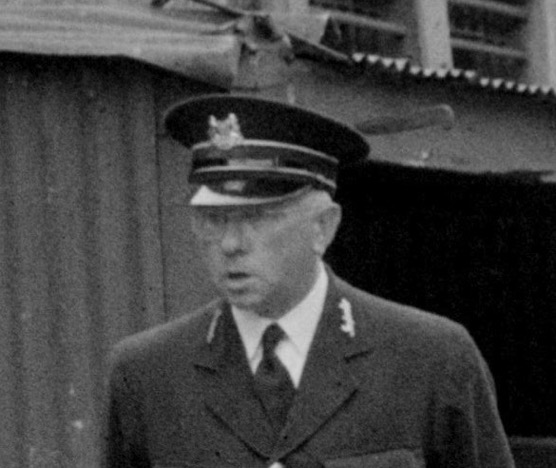
An enlargement of the above photograph showing the broad shape of the cap badge.
Female staff
A postcard view of a what is purportedly the entire female conducting staff, taken on the 19th June 1915.
A motorman and a conductress pose with Tramcar No 81 at Mannofield Terminus — photo undated, but certainly taken during or shortly after the Great War. In this shot, the conductress is wearing a dark-coloured bonnet, probably issued for use in summer. Photo courtesy of the Tramways and Light Railway Society, with thanks to David Voice.
A group comprising two motorwomen and a conductress — photo undated, but almost certainly taken during the Great War. Headgear takes the form of a large-crown peaked cap (here with white rain cover), on the face of it, identical to those worn in the Second World War, save for a cloth-covered rather than a shiny peak.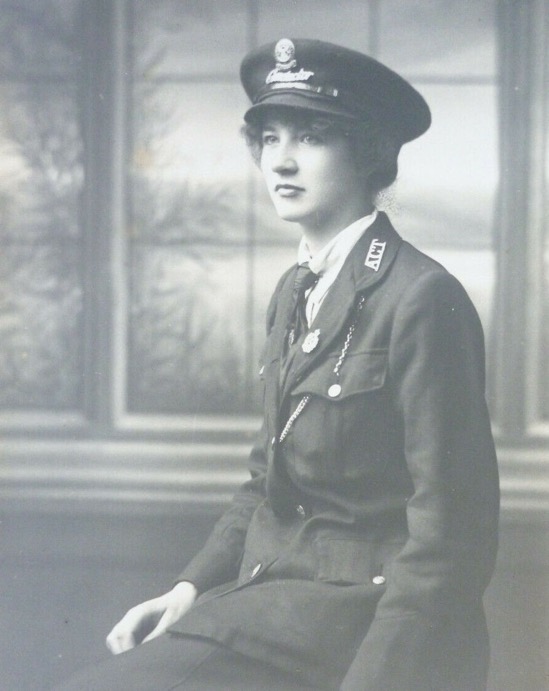
A charming study of a Great War ACT conductress, possibly named Nell. Whereabouts of original unknown.
Another studio portrait of the same Great War conductress as previously, but this time in a single-breasted jacket with a single slit-top breast pocket rather than the usual style with two button-closed breast pockets.
An Aberdeen conductress issuing a ticket aboard a tramcar on Union Street, sometime during the Second World War. Photo courtesy of the Stephen Howarth Collection.
A studio portrait of an Aberdeen Corporation Transport conductress — photo undated, but probably taken during or shortly after the Second World War. Note the absence of the red enamel ACT cap badge worn on men's caps, as well as the use of an underlined grade badge. Photo courtesy of the Stephen Howarth Collection.